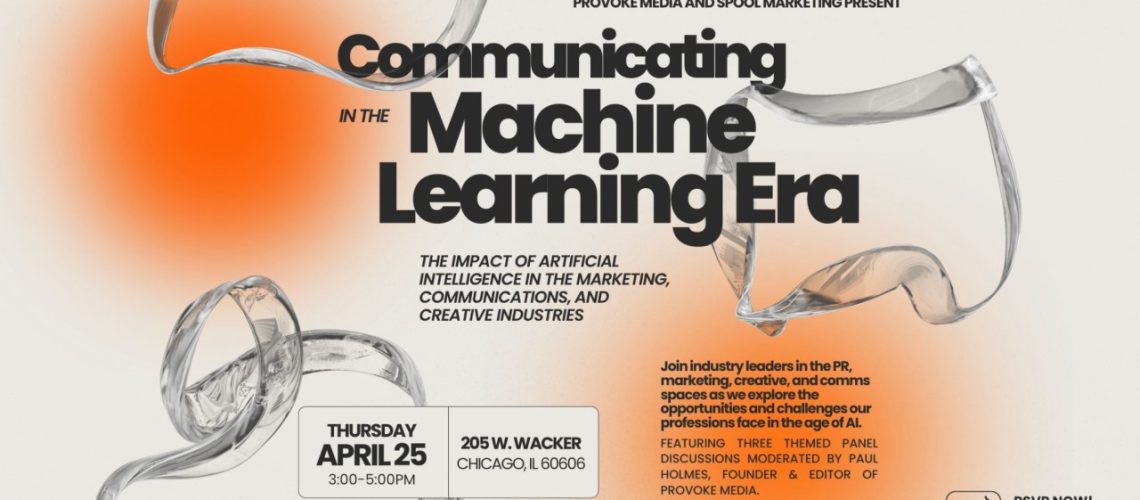On Thursday, April 25, Spool Marketing & Communications hosted its “Communicating in the Machine Learning Era” panel to discuss the impact and implications of artificial intelligence (AI) in the marketing, communications and creative industries.
Our goal in hosting this discussion was to bring together differing backgrounds and perspectives to dissect and discuss the specific ways AI is changing and evolving our industry and what we as professionals need to know when it comes to both leveraging its power and using it to our advantage, but also the areas that give us pause and how we can help mitigate its negative impacts.
Luckily, we have a wide network of people who feel as urgent and passionate about this as we do, and were joined by multiple industry experts who helped us achieve just that.
With so much to cover, we divided our experts into three panels in effort to dig deeper into these specific topics:
- How can AI be implemented into practices revolving around predictive analytics, risk management and the metrics that marketers rely upon?
- Insights from Holly Skillin, executive director of corporate affairs at KPMG and Charlie Baldwin, SVP of insights and analytics at WE Communications,
- With all the misinformation in the world and the rise of citizen journalism alongside the growth of social media, can AI be part of the solution?
- Insights from Shilpa Gadhok, founder and CEO of SEE GOOD STRATEGY GROUP, Justin Kaufmann, reporter at Axios, Chris Perry, chief innovation officer and chairman, futures at Weber Shandwick and Bradley Akubuiro, Partner at Bully Pulpit.
- Intellectual property rights are delicate and the rise of AI and generative AI challenged the creative world by asking, “Can AI-generated work be copyrighted? Who owns it? Where is it pulling source material from?”
- Insights from Spool’s own creative director and vice president, Colin Ofloy, Brian Cason, senior strategist at Pahnke US, Alan Kercinik, independent brand communications consultant and Alan Parker, chief innovation officer, Energy BBDO.
Paul Holmes, founder and chair of PRovoke Media, moderated the panel discussions, while adding plenty of additional insights and examples (and a few tough questions!) that really got us all thinking.
With so many experts weighing in on these crucial topics, we had plenty to discuss in the room, but were left with even more to consider as we all take these important insights back to our respective agencies and organizations.
The TL;DR?
Users familiar with the most popular platforms providing AI solutions know that while it can be a great conversational partner, it can also extrapolate and conjure its fair share of embellishments in how it presents its findings and responses. Predictive analytics are crucial marketing tools that allow the informed communications professional to develop and implement campaigns that aren’t just responsive to consumer feedback, but anticipate trends further down the marketing funnel. This creates a campaign that delivers for both clients and consumers alike and deepens the connection and level of understanding between a business and its target audience.
Here are a few additional, deep-dive highlights from our panel conversations:
When AI Gets It Wrong
The nature of gen-AI models means that they’re going to be pulling from data sets whenever possible or instructed to. The onus is on the user and how they’re designing an instructional prompt. A well constructed query is ideally met with recent information from strong and reliable sourcing.
A poorly constructed query is often met with numerous inaccuracies, fabricated retellings and pure guesswork. These issues can be easily caught by professionals with an informed background or experience and just as easily believed by those without.
As marketers look to expand their horizons and offerings through the integration of generative AI in their work, they have a responsibility to make sure their offerings are being properly represented.
Can AI Be A Trusted Source?
Sourcing in the age of social media’s floruit was already on thin ice. As the line between definitive fact and fiction becomes blurred by tumultuous political landscapes and a shifting expectation for social media regulation, AI is being trusted to answer questions that otherwise could have been reserved for a quick Google search or reference to another primary source.
Can AI Be An Artist?
Generative-AI can work in the visual space, too. For creatives, such as Colin Ofloy, sometimes it can be a quick sketchbook for the mind. While larger marketing efforts can include full photoshopping efforts, generative imaging through the use of artificial intelligence has reached previously unseen heights and now basically anyone can do it. Marketers are seeing new opportunities to appease audience demands through these capabilities, but the industry is reaching a new threshold and begs the question, “Who owns this?” As mentioned by one of our panelists, filing an intellectual property claim requires a foundational explanation of the contributions to the work in addition to significant impact.
As creatives continue to navigate this space, it’s up to them whether or not to turn to AI for their next brainstorming session. Audiences aren’t fully sold on the idea of AI in creative work, especially when there are plenty of creative minds ripe for the choosing and are actively seeking work. Additionally, creatives should be mindful of how these visual AI models are trained and should make sure that finalized work features an AI disclosure and doesn’t encroach on the styles or methods of true artists in the space.
As panelist Alan Kercinik said, “AI is less an innovation and more a discovery.” It does come down to the industry professionals to make sure this resource isn’t being abused or lacking infrastructure or guidance. We are surely in the early days of AI, and this discussion will be vastly different in five years. Today’s marketing and communications professionals will need to be hypervigilant in how they’re using artificial intelligence and will be looked to as leaders in the years to come.


